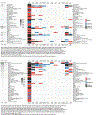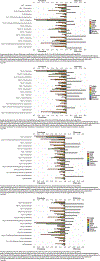The contribution of copy number variants to psychiatric symptoms and cognitive ability
- PMID: 36737482
- PMCID: PMC10213133
- DOI: 10.1038/s41380-023-01978-4
The contribution of copy number variants to psychiatric symptoms and cognitive ability
Abstract
Copy number variants (CNVs) are deletions and duplications of DNA sequence. The most frequently studied CNVs, which are described in this review, are recurrent CNVs that occur in the same locations on the genome. These CNVs have been strongly implicated in neurodevelopmental disorders, namely autism spectrum disorder (ASD), intellectual disability (ID), and developmental delay (DD), but also in schizophrenia. More recent work has also shown that CNVs increase risk for other psychiatric disorders, namely, depression, bipolar disorder, and post-traumatic stress disorder. Many of the same CNVs are implicated across all of these disorders, and these neuropsychiatric CNVs are also associated with cognitive ability in the general population, as well as with structural and functional brain alterations. Neuropsychiatric CNVs also show incomplete penetrance, such that carriers do not always develop any psychiatric disorder, and may show only mild symptoms, if any. Variable expressivity, whereby the same CNVs are associated with many different phenotypes of varied severity, also points to highly complex mechanisms underlying disease risk in CNV carriers. Comprehensive and longitudinal phenotyping studies of individual CNVs have provided initial insights into these mechanisms. However, more work is needed to estimate and predict the effect of non-recurrent, ultra-rare CNVs, which also contribute to psychiatric and cognitive outcomes. Moreover, delineating the broader phenotypic landscape of neuropsychiatric CNVs in both clinical and general population cohorts may also offer important mechanistic insights.
© 2023. The Author(s), under exclusive licence to Springer Nature Limited.
Conflict of interest statement
COMPETING INTERESTS
The authors declare no competing interests.
Figures




References
-
- Kirov G CNVs in neuropsychiatric disorders. Hum Mol Genet. 2015;24:R45–49. - PubMed
-
- Kirov G, Rees E, Walters J. What a psychiatrist needs to know about copy number variants. BJPsych Adv. 2018;21:157–63.

